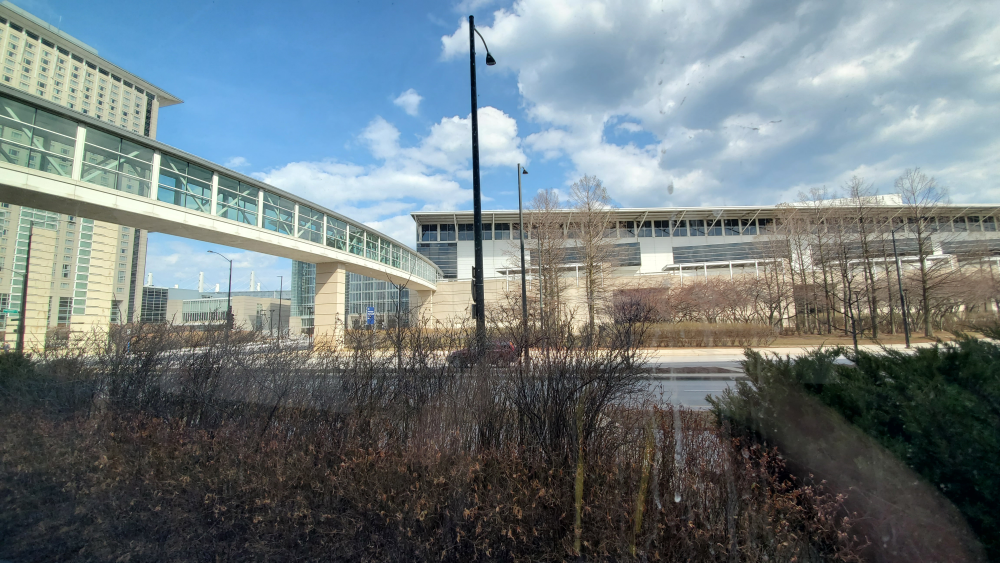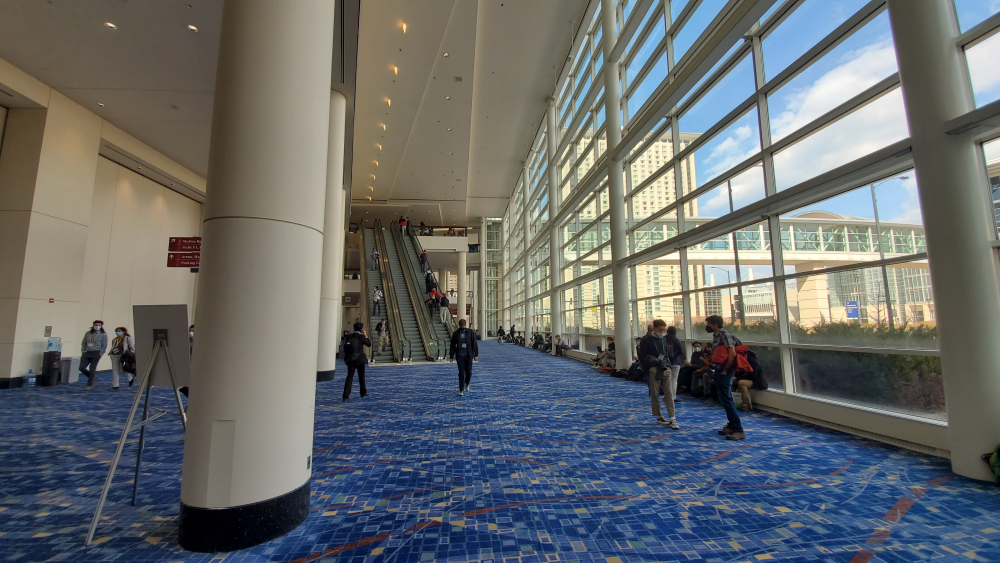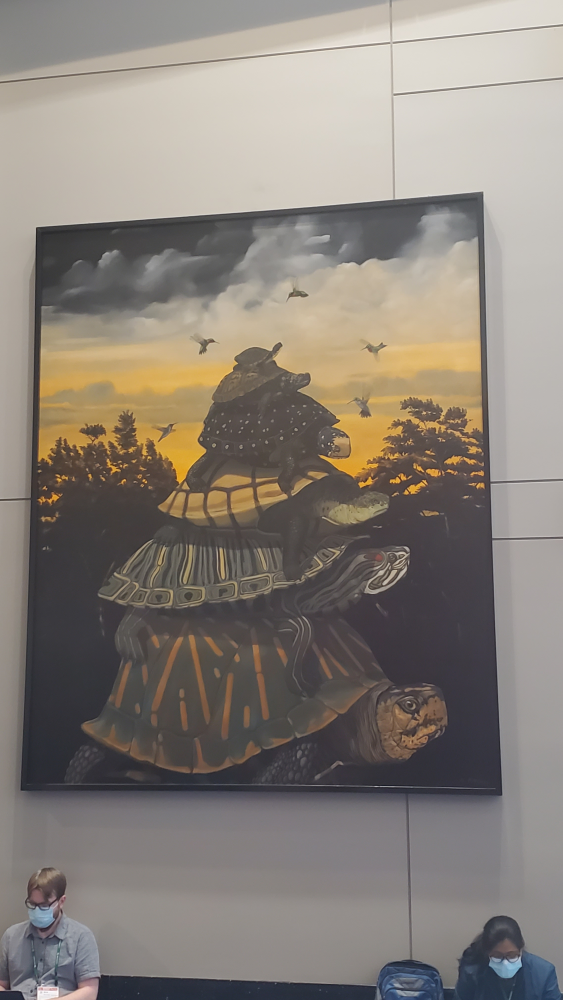APS March Meeting 2022, Chicago, IL
The following talks were presented at the 2022 APS March Meeting in Chicago, March 14-18:
Photoswitching of terahertz structural dynamics in the photosynthesis photo protective orange carotenoid protein
Presented by: Andrea Markelz
Authors:
J. A. Mckinney, D. K. George, Y. Deng, R. R. Thompson, C. Kerfeld, X. Liu, T. Romo, A. Grossfield, & A. G. Markelz
Abstract:
Protein long-range structural vibrations enable efficient conformational transitions during biological function. Conformational changes play a critical role in the regulation of activity of the photo protective protein, orange carotenoid protein (OCP). Exposure to bright blue-green light results in conversion from the compact orange resting state (OCPo) to the open active red state (OCPR) which can then interact with the light harvesting antenna, the phycobilisome (PBS), to induce fluorescent quenching. We examine how structural vibrations may actuate the transition using anisotropic terahertz microspectroscopy (ATM). We find that the intramolecular vibrations switch with photo excitation, with reversible shifting of the anisotropic bands in the ca. 50 cm-1 range. Comparison with normal mode ensemble analysis calculations indicates that the measured changes coincide with the loss of the H-bonds between residues Y201 and W288 and the keto group of the carotenoid in the C terminal domain. This change in the internal dynamics with the initial photoexcitation may provide the motional bias towards the subsequent reorganization of the N-terminal domain (NTD) and the eventual opening between the NTD and the C- terminal domain necessary for the interaction with the phycobilisome.
Grant:
This work is supported by DOE grant DE-SC0016317.
![]()
Crystal symmetry effects on protein anisotropic absorption
Presented by: Alex McNulty-Romaguera
Authors:
A. J. McNulty-Romaguera, J. A. McKinney, D. K. George, X. Zhang, J. Benedict, T. Romo, A. Grossfield, & A. G. Markelz
Abstract:
Long-range protein structural vibrations provide dynamical access to intermediate conformations during biological function. Anisotropic Terahertz Microspectroscopy provides a method of measuring these vibrations. To identify the measured resonances with structural motions we compare the spectra to normal mode ensemble analysis calculations. The anisotropic absorbance depends on the orientation of the molecules relative to the light polarization. This orientation is set by the crystal symmetry group and crystal facet perpendicular to the light propagation. We determine this polarization plane using X-ray crystal face indexing for monoclinic and triclinic hen egg white lysozyme crystals. For monoclinic crystals, unit cell parameters are in agreement with fully hydrated monoclinic symmetry seen in 2D4K.pdb, and with a polarization plane given by the [101] face. Using this, the calculated monoclinic spectra show agreement with the measured spectra. For triclinic crystals, face indexing of the polarization plane did not correspond to a simple index plane. The polarization plane was determined by combining indexing of the other facets with the measured dimensions. The resulting calculated triclinic spectra agreed with observed asymmetry in the spectra and spectral resonances.
Grant:
This work is supported by NSF grants DBI 1556359 and MCB 1616529, DOE grant DE-SC0016317
![]()
![]()
Photo-switching in crystalline OCP
Presented by: Robert Thompson
Authors:
R. R. Thompson, A. G. Markelz, T. LaFave, D. K. George, & J. A. McKinney
Abstract:
Orange Carotenoid Protein (OCP) is a photoprotective protein in cyanobacteria. In solution under high UV intensity, OCP switches from its resting state, or orange state, OCPO, peak absorbance at 495 nm, to its photoprotective red state, OCPR peak absorbance 515 nm. The transition involves a large scale structural reorganization that enables fluorescence quenching. Time resolved X-ray crystallography and anisotropic terahertz microspectroscopy (ATM) can measure the sequence of the structural and dynamical changes occurring with the transition, however these techniques require protein crystals, and to date photo switching has not been demonstrated in OCP crystals. Here we report the conditions to achieve crystal phase photoswitching. Using a homebuilt micro spectrometer, we found that in solution, photoswitching with 65 mW at 450 nm within 10 s results in a peak change in absorbance at 550 nm. Photoswitching for the crystals was found with the same power as the solution, but only after 2 min. of illumination. The red state appears to be irreversible after at least 2 days, and the peak in the change in the absorbance for the crystal phase shifts to 565 nm. The results provide the first demonstration that the early steps in photoprotective state transition are accessible in crystals.
Grant:
This work is supported by NSF grants DBI 1556359 and MCB 1616529, DOE grant DE-SC0016317 and NIH STTR R41 GM140587-01A1
![]()
![]()
![]()
![]()
Assignment of protein collective structural vibrations steering conformational change
Presented by: Xing Liu
Authors:
X. Liu & A. G. Markelz
In collaboration with Tod Romo, Alan Grossfield (University of Rochester)
Abstract:
Collective vibrations from elastic network models (ENM) have been used to predict protein intermediate state structures. The underlying assumption is that these vibrational displacements provide a trajectory towards the intermediate state conformation. In reality structural vibrations have small displacement amplitudes, insufficient to reach the intermediate state. Further ENM vibrations do not capture the complexity and variability of an all atom system which samples multiple configurations. Despite this variability, measurements of the anisotropic terahertz absorption find spectral structure for macroscopic protein samples indicating specific displacement directions concentrated in specific energy bands emerge from this complexity. This suggests that while no single vibration is responsible for a conformational transition, the overall dynamics of the system is biased towards the intermediate state displacements. Here we present strategies to assign the spectrally observed bands with structural displacements based on normal mode ensemble analysis (NMEA). A projection analysis on a full ensemble of vibrations of lysozyme using a vibrational displacement basis set from ENM shows narrow frequency ranges are dominated by specific displacements. As a second strategy, we examine correlations in structural displacements for resonant bands in the calculated anisotropic absorbance for the photo protective protein, orange carotenoid protein.
Grant:
This work is supported by NSF grants DBI 1556359 and MCB 1616529, DOE grant DE-SC0016317 and NIH STTR R41 GM140587-01A1
![]()
![]()
![]()
![]()
![]()
Terahertz microspectroscopy: far-field fidelity degradation and recovery
Presented by: Tim (TJ) LaFave
Authors:
T. LaFave & A. G. Markelz
Abstract:
Terahertz near-field microspectroscopy is an emerging technique essential for characterization of novel materials and biomolecules. A popular technique utilizes a subwavelength aperture and a detector placed in the far-field. Growing interest in this technique is due to the advent of high-power frequency tunable THz sources and high sensitivity room temperature THz detectors. Severe limitations are found with resulting spectral artifacts arising from diffraction, sample geometry, aperture size, and nearby resonances. We model transmission of a focused 400 $\mu$m diameter Gaussian beam through c-cut single crystal sucrose, with a well-defined resonance at 1.985 THz, mounted on 150 $\mu$m and 200 $\mu$m diameter apertures using HFSS. Modeling is validated with Beer’s Law with respect to sample thickness. Spectral fidelity is found to deteriorate beyond ~750 μm from the aperture, illustrating the need for near-field detection. We find that spectral fidelity may extended to the far-field with a low-loss THz waveguide that may facilitate a thermally-sensitive THz detector. This work is anticipated to be of great interest to a broad community in which far-field detection is commonly used and value to the growing interest in the design and development of compact THz microspectroscopy instruments.
Grant:
This work is supported by NSF grants DBI 1556359 and MCB 1616529, DOE grant DE-SC0016317 and NIH STTR R41 GM140587-01A1.
![]()
![]()
![]()
![]()
![]()
Simplifying protein collective vibrational assignment through symmetry
Presented by: Andrea Markelz
Authors:
D. K. George, J. A. McKinney, Y. Deng, A. J. McNulty-Romaguera, X. Zhang, J. Benedict, T. Romo, & A. G. Markelz
Abstract:
Anisotropic terahertz microspectroscopy (ATM) isolates protein collective vibrations from a highly congested spectrum based on the direction of the vibrational transition dipole. ATM changes with inhibitor binding and photo excitation reveal that the vibrational bath evolves with functional state. Assignment of the spectral bands to specific structural motions is needed to understand the impact of these dynamical changes. The complexity of the anisotropic spectral structure is dependent on the alignment of the molecules. This alignment is achieved by crystallization, which results in biomacromolecular arrays along with 30-70% water by volume. We examine crystal symmetry effects on the anisotropic spectra for hen egg white lysozyme crystals (HEWL). ATM measurements of triclinic, monoclinic and tetragonal HEWL crystals identify the conserved versus unique spectral features. Peaks near 40 cm−1 and 55 cm−1 were common among three lattice systems while a peak near 20 cm−1 was observed only in triclinic CEWL. Further we find that the spectral structure decreases with increasing symmetry, an expected result from dipole cancellation. The spectral symmetry shows good agreement with normal mode ensemble analysis calculations providing initial assignment of the bands.
Grant:
This work is supported by NSF grants DBI 1556359 and MCB 1616529, DOE grant DE-SC0016317
![]()
![]()
Impact of protein crystal contact forces on intramolecular picosecond dynamics
Presented by: Alex McNulty-Romaguera
Authors: J. A. McKinney, D. K. George, X. Zhang, J. Benedict, A. J. McNulty-Romaguera, T. Romo, & A. G. Markelz
Abstract:
While many protein dynamics studies depend on crystal phase measurements, it is not known how the intermolecular interactions effect these dynamics. We examine the dynamical impact of intermolecular interactions by measuring the collective structural vibrations using anisotropic terahertz microspectroscopy and tuning interactions through controlled dehydration of the crystal water content. For tetragonal and triclinic crystals no frequency shifts are observed. Instead, the bands initially narrow then broaden with dehydration, consistent with increased and then decreased ordering as found in X-ray crystallography. For monoclinic crystals on the other hand, we find strong anisotropic bands at 14.8 and 21.6 cm-1, which blue shift by 5.0 and 3.1 cm-1 respectively. This blue shift in the vibrations suggests a stiffening of the potential due to either a reduction in the solvent, an increase in the interaction with the neighboring molecules or both. Monoclinic lysozyme crystals are known to reversibly transform to another monoclinic form due to dehydration, thus it is possible that the spectral shifts are associated with this new ordering and not changes in the interactions. We explore these different possible mechanisms by comparison with Normal Mode Ensemble Analysis calculations.
Grant:
This work is supported by NSF grants DBI 1556359 and MCB 1616529, DOE grant DE-SC0016317.
![]()
![]()
Markelz Research Group at APS March Meeting, Chicago, 2022
Around McCormick Place West, Chicago, Illinois
photos by Tim (TJ) LaFave














